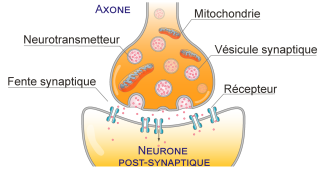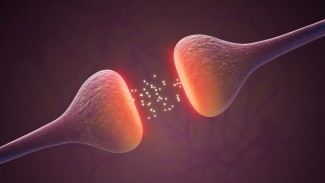A neurotransmitter is a chemical molecule produced and released by a neuron that transmits messages by binding to other cells.
Neurotransmitters (or neuromediators) play an essential role in our brains and bodies. They allow nerve cells, known as neurons, to communicate with each other. This communication is essential for everything we do: thinking, moving, feeling emotions, and even sleeping.
What is a neurotransmitter?
Neurotransmitters are chemical molecules that allow signals to be transmitted between a neuron and a cell.
Stored in the vesicles, they are released by neurons called presynaptic neurons (and sometimes by glial cells). They exert action on other neurons called post-synaptic neurons, or in rare cases on other types of cells such as muscle cells and certain glial cells, for example astrocytes.
Once emitted, these chemical substances bind to receptors located on the targeted neighboring cell, triggering an excitatory or inhibitory response.
This process happens incredibly fast: in just a fraction of a second, information can travel long distances in the brain and nervous system. Thanks to neurotransmitters, our body can react instantly to stimuli like removing our hand from a burning hot object, or feeling content when listening to music that we like.

What can be considered a neurotransmitter: the criteria
To be part of the family of neurotransmitters, a molecule has to meet several criteria:
- It must be produced by a neuron
- It must be present in the neuron’s terminal buttons
- It must be released when an action potential or nerve impulse occurs.
- It must exert an effect on the post-synaptic neuron
- It must be degraded or recaptured shortly after being emitted.
Excitatory and inhibitory signals
Post-synaptic neurons receive and process a large number of signals from neurotransmitters released by pre-synaptic neurons. To process all of these signals, the receiving neuron adds them up. If the total sum of the signals is mainly excitatory, the neuron becomes activated and triggers an action potential that alters the activity of nearby neurons. If, on the other hand, the sum of the signals is mainly inhibitory, the neuron is not activated.
This adding up of responses is called summation. The response to this summation is also dependent on the number of pulses received, and the intervals in which they are emitted. The response of a post-synaptic neuron will therefore be greater if the number of excitatory pulses is received over a short period of time.
The main neurotransmitters of the central nervous system and their roles
These are some of the most important neurotransmitters:
Dopamine: the pleasure and motivation molecule
Dopamine is often associated with pleasure, motivation and reward.It plays a key role in our willingness to complete tasks and in our sense of satisfaction after success. A dopamine imbalance can be a factor in disorders such as depression and Parkinson’s disease.
Serotonin: the mood regulator
Serotonin influences our mood, sleep and our appetite.Low levels of serotonin are often linked to anxiety and to depression.That’s why some anti-depressants are designed to increase dopamine availability in the brain.
Acetylcholine: essential to memory and learning
This neurotransmitter is crucial to memory, learning and muscle movement. It also plays an important role in attention. A drop in acetylcholine levels is associated with neurodegenerative diseases such as Alzheimer’s disease.
GABA: the nervous system’s brake
GABA (gamma-aminobutyric acid) is an inhibitory neurotransmitter, which means that it slows down neuronal activity. It helps to reduce stress and anxiety by preventing the brain from becoming overstimulated. That’s why it is often used in anxiolytic medications.
Glutamate: fuel for learning
Unlike GABA, glutamate is an excitatory neurotransmitter that stimulates brain activity. It is involved in learning, memory and brain development. However, too much glutamate can be toxic and can cause neuronal damage.
Endorphins: natural painkillers
Endorphins act as natural analgesics. They are released in response to pain and intense physical exertion, providing a sense of well-being, which is why sports can improve mood.
Noradrenaline: a powerful vasoconstrictor
Noradrenaline (or norepinephrine) is a neurotransmitter and hormone that plays an important role in regulating stress, attention and alertness.
Noradrenaline exerts a very powerful action on alpha receptors and a more moderate action on beta 1 receptors. It causes generalized vasoconstriction. It is used in treatments for depression.
Why are neurotransmitters so important?
Neurotransmitters are involved in almost all functions of our bodies and minds. An imbalance in neurotransmitters can cause a range of neurological and psychiatric disorders like depression, anxiety, schizophrenia, and even Alzheimer’s disease.
- Neuron :
- Basic cell of the nervous tissue, capable of receiving, analysing, reproducing and transmitting information in the form of an electrical or chemical signal.

